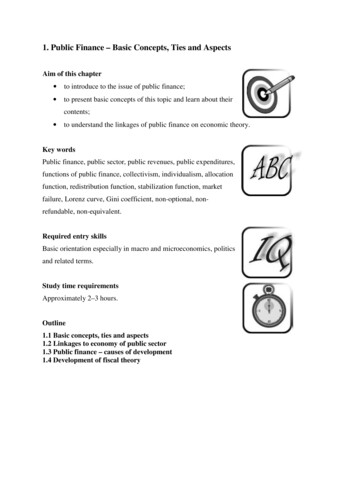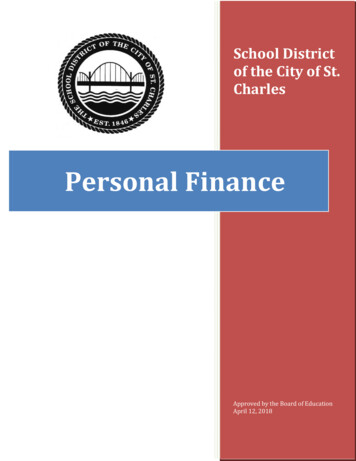
Transcription
Personal Finance Unit 2 Chapter 5 2007 Glencoe/McGraw-Hill0
Chapter 5BankingWhat You’ll Learn Section 5.1 Identify types of financial services. Describe the various types of financial institutions. Section 5.2 Compare the costs and benefits of different savingsplans. Explain features of different savings plans. Compare the costs and benefits of different types ofchecking accounts. Explain how to use a checking account effectively.Personal Finance Unit 2 Chapter 5 2007 Glencoe/McGraw-Hill1
Savings Account Q: I make only 75 a week at my part-time job and usemost of it for movies, food, and CDs. Because I make solittle, do I really need to put my money in a bank? A: Since you have a small amount of money to take careof, you may not need a bank. However, 75 a week is alarge sum to spend on entertainment. You should open asavings account and try to save at least 10 a week. Afterthree months you would have 130, and after a year youwould have more than 500.Go to finance07.glencoe.com to complete the Standard &Poor’s Financial Focus activity.Personal Finance Unit 2 Chapter 5 2007 Glencoe/McGraw-Hill22
Section 5.1Financial Services and InstitutionsMain IdeaWhat might be thedifferencesbetweencommercialbanks, savingsand loans, andcredit unions?Understanding the features of financial services andinstitutions will help you choose options that bestmeet your needs.Personal Finance Unit 2 Chapter 5 2007 Glencoe/McGraw-Hill33
Section 5.1Financial Services and InstitutionsHow to Manage Your CashToday, with more than 11,000 banks, 2,000savings and loan associations, and 12,000credit unions in the United States, you have awide array of financial services from which tochoose.Your choice of financial services will depend onyour: Daily cash needs Savings goalsPersonal Finance Unit 2 Chapter 5 2007 Glencoe/McGraw-Hill4
Section 5.1Financial Services and InstitutionsDaily Cash NeedsYour daily cash needs may include: Buying lunch Going to the movies with friends Filling the car with gasoline Paying for other routine activitiesConsider the pros and cons of each method youcan use for your everyday cash needs.Personal Finance Unit 2 Chapter 5 2007 Glencoe/McGraw-Hill5
Section 5.1Financial Services and InstitutionsSources of Quick CashRegardless of how well you plan, you maysometimes need more cash than you haveavailable. You have two options: Use your savings. Borrow the money.Remember that either choice requires a tradeoff. Although you will have immediate access tothe funds you need, long-term financial goalsmay be delayed.Personal Finance Unit 2 Chapter 5 2007 Glencoe/McGraw-Hill6
Section 5.1Financial Services and InstitutionsTypes of Financial ServicesIn order to stay competitive in today’smarketplace, banks and other financialinstitutions have expanded the range of servicesthat they offer.These services can be divided into three maincategories: Savings Payment services BorrowingPersonal Finance Unit 2 Chapter 5 2007 Glencoe/McGraw-Hill7
Section 5.1Financial Services and InstitutionsSavingsSafe storage of funds for future use is a basicneed for everyone.Some examples of time deposit funds include: Money that you keep in any type ofsavings account Certificates of deposit or CDsHaving a savings account is essential for anypersonal finance plan.Personal Finance Unit 2 Chapter 5 2007 Glencoe/McGraw-Hill8
Section 5.1Financial Services and InstitutionsPayment ServicesTransferring money from a personal account tobusinesses or individuals for payments is abasic function of day-to-day financial activity at abank.The most commonly used payment service is achecking account. Money that you place in achecking account is: Called a demand deposit Able to be withdrawn at any time, or ondemandPersonal Finance Unit 2 Chapter 5 2007 Glencoe/McGraw-Hill9
Section 5.1Financial Services and InstitutionsBorrowingMost people use credit at some time during theirlives. If you need to borrow money, financialinstitutions allow you to: Borrow money for a short term by using acredit card or taking out a personal cashloan. Borrow money for a longer term byapplying for a mortgage or auto loan.Personal Finance Unit 2 Chapter 5 2007 Glencoe/McGraw-Hill10
Section 5.1Financial Services and InstitutionsOther Financial ServicesFinancial institutions may also offer a variety ofservices, such as: Insurance protection Stock, bond, and mutual fund investmentaccounts Income tax assistance Financial planning servicesPersonal Finance Unit 2 Chapter 5 2007 Glencoe/McGraw-Hill11
Section 5.1Financial Services and InstitutionsElectronic Banking ServicesYour bank’s electronic services allow you to: Check the status of your account. Make a transaction from an ATM, bytelephone, or online. Get up-to-date information with personalfinancial management software.Security is the number one issue for onlinecustomers. The way to ensure online security isto: Use a security code, or password. Use a customer identification name ornumber.Personal Finance Unit 2 Chapter 5 2007 Glencoe/McGraw-Hill12
CASH AT HAND Follow simple rules of ATM etiquette when usingthis banking convenience. If you are in line, stand at least a fewfeet away from the person who is using the machine. When youare at the machine, protect the screen as you enter your PIN andother information. Why are these practices important?Personal Finance Unit 2 Chapter 5 2007 Glencoe/McGraw-Hill13
Section 5.1Financial Services and Institutionsdirect depositan automaticdeposit of net payto an employee’sdesignated bankaccountDirect DepositMany businesses offer their employees directdeposit. Instead of a paper paycheck,employees receive a printed statement that lists: Deductions Other information about their earningsDirect deposit offers a save way to transferfunds and saves: Time Money EffortPersonal Finance Unit 2 Chapter 5 2007 Glencoe/McGraw-Hill14
Section 5.1Financial Services and InstitutionsAutomatic PaymentsWith your authorization, your bank can withdrawthe amount of your monthly payments or billsfrom your bank account.In order to use automatic payments, you willneed to: Make sure you always have enoughmoney in your account for the payment. Arrange your payments according towhen you receive your paycheck. Check your bank statements each monthto make sure that the payments weremade correctly.Personal Finance Unit 2 Chapter 5 2007 Glencoe/McGraw-Hill15
Section 5.1Financial Services and Institutionsautomated tellermachine (ATM)a computerterminal thatallows awithdrawal ofcash from anaccountdebit carda cash card thatallows you towithdraw moneyor pay forpurchases fromyour checking orsavings accountAutomated Teller Machines (ATMs)A cash machine, or automated teller machine(ATM), allows you to: Withdraw cash from an account Make deposits Transfer money from one account toanotherTo use an ATM for banking, you must apply fora debit card from your financial institution.Unlike a credit card, a debit card enables you tospend only the money that you have in youraccount.Personal Finance Unit 2 Chapter 5 2007 Glencoe/McGraw-Hill16
Section 5.1Financial Services and InstitutionsATM FeesThe fees that some financial institutions chargefor the convenience of using an ATM can addup over time. You might consider thesesuggestions: Compare ATM fees before opening anaccount. Use your bank’s ATM machines to avoidthe additional fees that other bankscharge when you use their machines. Consider using traveler’s checks, creditcards, personal checks, and prepaid cashcards when you are away from home.Personal Finance Unit 2 Chapter 5 2007 Glencoe/McGraw-Hill17
Section 5.1Financial Services and Institutionspoint-of-saletransactiona purchase by adebit card of agood or service ata retail store, arestaurant, orelsewherePlastic PaymentsAlthough cash and checks are very commonmethods of paying for goods and services,various access cards are also available. Theseinclude: Point-of-sale transactions Store-value cards Electronic cashPersonal Finance Unit 2 Chapter 5 2007 Glencoe/McGraw-Hill18
Section 5.1Financial Services and InstitutionsOpportunity Costs of FinancialServicesWhen you are making decisions about savingand spending: Try to find a balance between your shortterm needs and your future financialsecurity. Consider the opportunity costs, or tradeoffs, of each choice you make as youselect financial services.Remember to consider the value of your time inaddition to the money you are saving.Personal Finance Unit 2 Chapter 5 2007 Glencoe/McGraw-Hill19
Section 5.1Financial Services and InstitutionsTypes of Financial InstitutionsAfter you have identified the services you want,you can choose from among many types offinancial institutions.You may select an institution that: Offers a wide range of services Specializes in certain services Provides the option of cyber-banking, orbanking via the Internet Operates exclusively on the InternetPersonal Finance Unit 2 Chapter 5 2007 Glencoe/McGraw-Hill20
Section 5.1Financial Services and InstitutionsFederal Deposit Insurance CorporationThe Federal Deposit Insurance Corporation(FDIC): Protects deposits in banks Insures each account in a federallychartered bank up to 100,000 peraccount Administers the Savings AssociationInsurance Fund (SAIF) for savings andloan associationsAll federally chartered banks must participate inthe FDIC program.Personal Finance Unit 2 Chapter 5 2007 Glencoe/McGraw-Hill21
Section 5.1Financial Services and Institutionscommercial banka for-profitinstitution thatoffers a full rangeof financialservices, includingchecking, savings,and lendingcredit uniona nonprofitfinancial institutionthat is owned byits members andorganized for theirbenefitDeposit InstitutionsMost people use deposit-type institutions tohandle their banking needs. These institutionsinclude: Commercial banks Savings and loan associations Mutual savings banks Credit unionsPersonal Finance Unit 2 Chapter 5 2007 Glencoe/McGraw-Hill22
Section 5.1Financial Services and InstitutionsNon-Deposit InstitutionsFinancial services are also available atinstitutions such as: Life insurance companies Investment companies Finance companies Mortgage companiesPersonal Finance Unit 2 Chapter 5 2007 Glencoe/McGraw-Hill23
Section 5.1Financial Services and InstitutionsComparing Financial InstitutionsWhen you compare banks and other financialinstitutions, you should ask these questions tohelp choose the best one: Where can you get the highest rate ofinterest on your savings? Where can you obtain a checkingaccount with low (or no) fees? Will you be able to borrow money fromthe institution when you need it? Does it have online banking services? Does it have convenient locations?Personal Finance Unit 2 Chapter 5 2007 Glencoe/McGraw-Hill24
Section 5.2Savings Plans and Payment MethodsMain IdeaWhat is thedifferencebetween a CDand a moneymarket account?Recognizing the types of savings plans andpayment methods that financial institutions offercan help you use money wisely.Personal Finance Unit 2 Chapter 5 2007 Glencoe/McGraw-Hill25
Section 5.2Savings Plans and Payment MethodsTypes of Savings PlansTo achieve your financial goals, you will need asavings program. Various types of savingsprograms include: Regular savings accounts Certificates of deposit Money market accounts U.S. Savings BondsPersonal Finance Unit 2 Chapter 5 2007 Glencoe/McGraw-Hill26
Section 5.2Savings Plans and Payment MethodsRegular Savings AccountsRegular savings accounts, traditionally calledpassbook accounts, are ideal if you plan tomake frequent deposits and withdrawals. Theseaccounts: Require little to no minimum balance Allow you to withdraw money on demandThe trade-off for this convenience is that theinterest you earn will be low compared withother savings plans.Personal Finance Unit 2 Chapter 5 2007 Glencoe/McGraw-Hill27
Section 5.2Savings Plans and Payment Methodscertificate ofdeposit (CD)a savingsalternative inwhich money isleft on deposit fora stated period oftime to earn aspecific rate ofreturnCertificates of DepositA certificate of deposit (CD) is a relatively lowrisk way to invest your money.It offers a higher interest rate than a regularsavings account pays, but you will have to acceptthree key limitations: You may have to leave your money ondeposit for one month to five or more years. You probably will pay a penalty if you takethe money out before the maturity date. Financial institutions require that youdeposit a minimum amount to buy acertificate of deposit.Personal Finance Unit 2 Chapter 5 2007 Glencoe/McGraw-Hill28
Section 5.2Savings Plans and Payment MethodsCD Investment StrategiesHere are some tips for investing in CDs: Find out where you can get the best rate. Consider the economy as you decidewhat maturity date to choose. Never let a financial institution “roll over”a CD. Consider when you will need the money. If you have enough funds to have severalaccounts, you might consider creating aCD portfolio, which includes CDs thatmature at different times.Personal Finance Unit 2 Chapter 5 2007 Glencoe/McGraw-Hill29
Section 5.2Savings Plans and Payment Methodsmoney marketaccounta savingsaccount thatrequires aminimum balanceand earnsinterest thatvaries frommonth to monthMoney Market AccountsThe interest rates of a money market accountfloat, or go up and down, as market rateschange.Although the interest rate of a money marketaccount is usually higher than that of a regularsavings account: A money market account also requires ahigher minimum balance, typically 1,000. You may have to pay a penalty if yourbalance goes below the minimumamount.Personal Finance Unit 2 Chapter 5 2007 Glencoe/McGraw-Hill30
Section 5.2Savings Plans and Payment MethodsU.S. Savings BondsAnother savings option is purchasing a U.S.Savings Bond. The maturity date of a bonddepends on: The date it was bought The interest rate the bond is earningYour bond’s worth will depend on currentinterest rates and on the month and year inwhich the bond was issued.Personal Finance Unit 2 Chapter 5 2007 Glencoe/McGraw-Hill31
Section 5.2Savings Plans and Payment MethodsEvaluating Savings PlansYour selection of a savings plan will beinfluenced by several factors. You shouldconsider: The rate of return Inflation Tax considerations Liquidity Restrictions FeesPersonal Finance Unit 2 Chapter 5 2007 Glencoe/McGraw-Hill32
Section 5.2Savings Plans and Payment Methodsrate of returnthe percentagesof increase in thevalue of yoursavings fromearned interestcompoundingthe process inwhich interest isearned on boththe principal—theoriginal amountyou deposited—and on anypreviously earnedinterestRate of ReturnEarnings on savings can be measured by therate of return, or yield.Compounding can have a great impact onlarge amounts of money that are held in savingsaccounts for long periods.The more frequently your balance iscompounded, the greater your rate of return willbe.Personal Finance Unit 2 Chapter 5 2007 Glencoe/McGraw-Hill33
Section 5.2Savings Plans and Payment Methodsannualpercentage yield(APY)the amount ofinterest that a 100 depositwould earn, aftercompounding, forone year.Truth in SavingsAccording to the Truth in Savings law (Federalreserve Regulation DD), financial institutionshave to inform you of the following information: Fees on deposit accounts Interest rate Annual percentage yield (APY) Terms and conditions of the savings planThe APY helps you determine the amount youcan expect to earn on your money.Personal Finance Unit 2 Chapter 5 2007 Glencoe/McGraw-Hill34
Section 5.2Savings Plans and Payment MethodsInflationYou should compare the rate of interest youearn on your savings with the rate of inflation.Usually, the interest rates offered on savingsaccounts increase if the rate of inflationincreases.The biggest problem with inflation occurs if youare locked into a lower interest rate for a longperiod.Personal Finance Unit 2 Chapter 5 2007 Glencoe/McGraw-Hill35
Section 5.2Savings Plans and Payment MethodsTax ConsiderationsLike inflation, taxes reduce the interest earnedon savings. You may want to look into: Tax-exempt saving plans Tax-deferred savings plansPersonal Finance Unit 2 Chapter 5 2007 Glencoe/McGraw-Hill36
Section 5.2Savings Plans and Payment MethodsLiquidityCheck the savings plans you are considering todetermine whether early withdrawal of funds willcause them to: Charge a penalty Pay a lower rate of interestIf you are saving for long-term goals, a highinterest rate may be more important thanliquidity.Personal Finance Unit 2 Chapter 5 2007 Glencoe/McGraw-Hill37
Section 5.2Savings Plans and Payment MethodsRestrictions and FeesBe aware of any restrictions on savings plans,such as: A delay between the time when interest isearned and when it is actually paid intoyour account Fees for making deposits andwithdrawals Service charges you may have to pay ifyour balance drops below a certainamount or if you do not use your accountfor a certain periodPersonal Finance Unit 2 Chapter 5 2007 Glencoe/McGraw-Hill38
Section 5.2Savings Plans and Payment MethodsTypes of Checking AccountsChecking accounts can be divided into threemain categories: Regular accounts Activity accounts Interest-earning accountsPersonal Finance Unit 2 Chapter 5 2007 Glencoe/McGraw-Hill39
Section 5.2Savings Plans and Payment MethodsRegular Checking AccountsRegular checking accounts usually do notrequire a minimum balance. You may have topay a monthly service charge, however, if: The account requires a minimumbalance. Your account drops below that amount.Some institutions will waive a service charge ifyou keep a certain balance in your savingsaccount.Personal Finance Unit 2 Chapter 5 2007 Glencoe/McGraw-Hill40
Section 5.2Savings Plans and Payment MethodsActivity AccountsAn activity account might be right for you if you: Write only a few checks each month Are unable to maintain a minimumbalanceThe financial institution may charge a fee for: Each check you write Each depositIn addition, a monthly service fee will becharged.Personal Finance Unit 2 Chapter 5 2007 Glencoe/McGraw-Hill41
Section 5.2Savings Plans and Payment MethodsInterest-Earning Checking AccountsInterest-earning checking accounts are acombination of: Checking accounts Savings accountsThese accounts pay interest if you maintain aminimum balance.Personal Finance Unit 2 Chapter 5 2007 Glencoe/McGraw-Hill42
Section 5.2Savings Plans and Payment MethodsEvaluating Checking AccountsHow do you decide which type of checkingaccount will meet your needs? You will need toweigh several factors: Restrictions Fees and charges Interest Special servicesPersonal Finance Unit 2 Chapter 5 2007 Glencoe/McGraw-Hill43
Section 5.2Savings Plans and Payment MethodsRestrictionsThe most common restriction is the requirementthat you keep a minimum balance. Otherrestrictions may include: The number of transactions allowed The number of checks you may write in amonthPersonal Finance Unit 2 Chapter 5 2007 Glencoe/McGraw-Hill44
Section 5.2Savings Plans and Payment MethodsFees and ChargesYou may pay a monthly service charge as wellas fees for: Check printing Overdrafts Stop-payment ordersPersonal Finance Unit 2 Chapter 5 2007 Glencoe/McGraw-Hill45
Section 5.2Savings Plans and Payment MethodsInterestAn interest-earning checking account will beaffected by: Interest rates Frequency of compounding The way in which interest is calculatedPersonal Finance Unit 2 Chapter 5 2007 Glencoe/McGraw-Hill46
Section 5.2Savings Plans and Payment Methodsoverdraftprotectionan automatic loanmade to anaccount if thebalance will notcover checkswrittenSpecial ServicesChecking account services include: ATMs Banking by telephone and onlineAs a checking account customer, you may alsoreceive overdraft protection.Personal Finance Unit 2 Chapter 5 2007 Glencoe/McGraw-Hill47
Section 5.2Savings Plans and Payment MethodsUsing a Checking AccountAfter you select the type of checking accountthat best fits your needs, you need to know howto use it effectively.Personal Finance Unit 2 Chapter 5 2007 Glencoe/McGraw-Hill48
Personal Finance Unit 2 Chapter 5 2007 Glencoe/McGraw-Hill49
Section 5.2Savings Plans and Payment MethodsOpening a Checking AccountBefore you open a checking account, decidewhether you want: An individual account A joint accountPersonal joint accounts are usually “or”accounts, which means that only one of theowners needs to sign a check.Personal Finance Unit 2 Chapter 5 2007 Glencoe/McGraw-Hill50
Section 5.2Savings Plans and Payment MethodsWriting ChecksBefore writing a check, use your check registerto record the: Date Number of the check Name of the party who will receive thepayment Exact amount of the checkBe sure to keep a current balance of the moneyyou have by deducting from or adding to yourbalance the amount of any check transaction.Personal Finance Unit 2 Chapter 5 2007 Glencoe/McGraw-Hill51
Section 5.2Savings Plans and Payment MethodsSteps in Writing a CheckFollow these steps when you write a check: Write the current date. Write the name of the party who willreceive the check. Record the amount of the payment innumerals. Write the amount in words. Sign the check. Make a note of the reason for thepayment.Personal Finance Unit 2 Chapter 5 2007 Glencoe/McGraw-Hill52
Section 5.2Savings Plans and Payment Methodsstop-paymentordera request that abank or otherfinancialinstitution notcash a particularcheckStop-Payment OrderYou may ask the bank to issue a stop-paymentorder if: A check is lost or stolen. You want to take back your payment for abusiness transaction.Fees for this service can range from 10 to 20or more.Personal Finance Unit 2 Chapter 5 2007 Glencoe/McGraw-Hill53
Section 5.2Savings Plans and Payment Methodsendorsementthe signature ofthe payee, theparty to whom thecheck has beenwrittenMaking DepositsTo add money to your checking account: Fill out a deposit ticket. Endorse the back of each check youwant to deposit.Here are some tips to follow when endorsing acheck: Do not endorse a check until you areready to cash or deposit it. Use a pen so that your signature cannotbe erased. If depositing a check by mail, write “Fordeposit only” above your signature.Personal Finance Unit 2 Chapter 5 2007 Glencoe/McGraw-Hill54
Section 5.2Savings Plans and Payment MethodsCheck ClearingCheck clearing is a system that ensures that themoney you deposited in the account is availablefor withdrawal.Check-clearing rules vary by bank, so ask yourbank about its rules.Personal Finance Unit 2 Chapter 5 2007 Glencoe/McGraw-Hill55
Money TossEmpty the change from your pocket or wallet every night andthrow it into a jar. At the end of each month, deposit all your“throwaway” money in your savings or checking account. Thatloose change can really add up.What type of bank account would be best for your loosechange? Why?Personal Finance Unit 2 Chapter 5 2007 Glencoe/McGraw-Hill5656
Section 5.2Savings Plans and Payment MethodsKeeping Track of a Checking AccountEach month your bank will send you a statementthat shows your checking account activity for themonth. Your bank statement will list: Deposits Checks you have written ATM withdrawals Debit card charges Interest earned FeesThe balance reported on the bank statement maybe different from the balance in your checkregister.Personal Finance Unit 2 Chapter 5 2007 Glencoe/McGraw-Hill57
Section 5.2Savings Plans and Payment Methodsbankreconciliationa report thataccounts for thedifferencesbetween thebank statementand a checkbookbalanceReconciliationYou can fill out a bank reconciliation form todetermine your true balance.To balance, or reconcile, your account, followthese steps: Compare the checks you have writtenduring the month with those that arelisted on the bank statement as paid, orcleared. Determine whether any recent depositsare not on the bank statement. Subtract fees and charges listed on thestatement from your checkbook balance. Add interest earned to your checkbookbalance.Personal Finance Unit 2 Chapter 5 2007 Glencoe/McGraw-Hill58
Section 5.2Savings Plans and Payment MethodsOther Payment MethodsYou can make payments using methods otherthan writing a personal check. Somealternatives include: Certified checks Cashier’s checks Money orders Travelers check Prepaid travelers cardsPersonal Finance Unit 2 Chapter 5 2007 Glencoe/McGraw-Hill59
Section 5.2Savings Plans and Payment MethodsFinancial Institutions and YourMoneyBanks make money by making loans. Theamount of deposits held by a bank affects itsability to: Loan money Put money back into the economy to payfor goods and servicesBanking your money benefits you as well asothers in the economic system.Personal Finance Unit 2 Chapter 5 2007 Glencoe/McGraw-Hill60
Chapter 5BankingKey Term Review direct depositautomated teller machine (ATM)debit cardpoint-of-sale transactioncommercial banksavings and loan association (S&L)credit unioncertificate of deposit (CD)money market accountrate of return compoundingannual percentage yield (APY)overdraft protectionstop-payment orderendorsementbank reconciliationPersonal Finance Unit 2 Chapter 5 2007 Glencoe/McGraw-Hill61
Chapter 5BankingReviewing Key Concepts1.Explain two advantages and two disadvantages of onlinebanking.At any time of the day, you can use a bank’s electronic services to: Check the status of your account. Make a transaction.Security is the number one issue for online customers. You willneed to be careful to ensure that you do not become a victim ofidentity theft.Personal Finance Unit 2 Chapter 5 2007 Glencoe/McGraw-Hill62
Chapter 5BankingReviewing Key Concepts2.Identify the services offered by the different financialinstitutions.The three primary types of financial services are: Savings Payment services BorrowingPersonal Finance Unit 2 Chapter 5 2007 Glencoe/McGraw-Hill63
Chapter 5BankingReviewing Key Concepts3.Explain why a large, nationally chartered bank may be thesafest place to deposit your money.The Federal Deposit Insurance Corporation (FDIC) protectsdeposits in federally chartered banks and insures eachaccount up to 100,000 per account.Personal Finance Unit 2 Chapter 5 2007 Glencoe/McGraw-Hill64
Chapter 5BankingReviewing Key Concepts4.Discuss how you benefit when interest is compoundedmonthly as opposed to annually.The more frequently your balance is compounded, the greateryour rate of return will be.Personal Finance Unit 2 Chapter 5 2007 Glencoe/McGraw-Hill65
Chapter 5BankingReviewing Key Concepts5.Explain the circumstances under which a person shouldchoose a regular checking account, activity checkingaccount, or interest-earning checking account.Regular checking accounts usually do not require a minimumbalance.An activity account might be right for you if you: Write only a few checks each month. Are unable to maintain a minimum balance.Interest-earning accounts pay interest if you maintain a minimumbalance. If your account balance goes below the limit: You may not earn any interest. You may have to pay a service charge.Personal Finance Unit 2 Chapter 5 2007 Glencoe/McGraw-Hill66
Chapter 5BankingReviewing Key Concepts6.List the steps to take to use a checking account effectively.To use a checking account: Write checks carefully. Endorse checks you deposit. Reconcile your checkbook against bank statements.Personal Finance Unit 2 Chapter 5 2007 Glencoe/McGraw-Hill67
Newsclip: Fuzzy NumbersBanks offer many saving options to teenagers. A teen can open asavings/passbook account or CD (certificate of deposit).Log On Go to finance07.glencoe.com and open Chapter 5.Read about the different types of available savings options. Thenanswer this question: When is it the right time to save, and whattypes of savings accounts are available?Personal Finance Unit 2 Chapter 5 2007 Glencoe/McGraw-Hill68
Personal Finance Unit 2 Chapter 5 2007 Glencoe/McGraw-Hill 4 How to Manage Your Cash Today, with more than 1











